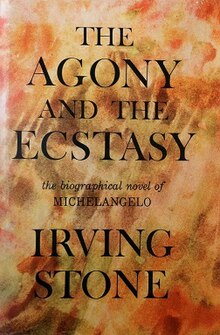The Agony and the Ecstasy (novel)

First edition
|
|
| Author | Irving Stone |
|---|---|
| Country | United States |
| Language | English |
| Genre | Biographical, Historical novel |
| Publisher | Doubleday |
|
Publication date
|
1961 |
| ISBN | |
| OCLC | 56555113 |
The Agony and the Ecstasy (1961) is a biographical novel of Michelangelo Buonarroti written by American author Irving Stone. Stone lived in Italy for years visiting many of the locations in Rome and Florence, worked in marble quarries, and apprenticed himself to a marble sculptor. A primary source for the novel is Michelangelo's correspondence, all 495 letters of which Stone had translated from Italian by Charles Speroni and published in 1962 as I, Michelangelo, Sculptor. Stone also collaborated with Canadian sculptor Stanley Lewis, who researched Michelangelo's carving technique and tools. The Italian government lauded Stone with several honorary awards for his cultural achievements highlighting Italian history.
Stone wrote a number of biographical novels, but this one and Lust for Life are his best known, in large part because both had major Hollywood film adaptations. Part of the 1961 novel was adapted to film in The Agony and the Ecstasy (1965), starring Charlton Heston as Michelangelo and Rex Harrison as Pope Julius II.
After Ghirlandaio looks at Michelangelo’s sketches of Christ drawn with a stonemason as the model, he tells Michelangelo the story of Donatello's showing his newly carved crucifix to Brunelleschi. Brunelleschi observes that it seems to him Donatello has, “put a plowman on the cross, rather than the body of Jesus Christ, which was most delicate in all its parts". Donatello, upset by his friend’s criticism, challenges Brunelleschi to make Christ’s figure himself. When Brunelleschi presents his own, newly finished crucifix, “Donatello, who could not take his eyes off the beautiful Christ, answered, ‘It is your work to make Christs, and mine to make plowmen.’” Michelangelo, familiar with both carvings, tells Ghirlandaio that he “preferred Donatello’s plowman to Brunelleschi’s ethereal Christ, which was so slight that it looked as though it had been created to be crucified. With Donatello’s figure the crucifixion had come as a horrifying surprise….”
...
Wikipedia
